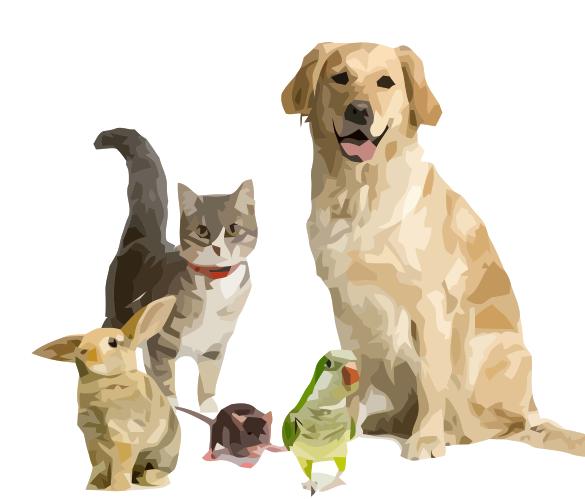Dogs and Other Pets: Can They Get Along?
Table of Contents

With patience and care, you can keep a dog successfully with other pets, especially cats. However, dogs are natural predators, and their instinct is to hunt any moving prey. It is always easier to introduce a puppy than an adult dog to other family pets, as its hunting instincts will not yet be strongly developed. To achieve a state of coexistence, you need to understand what is going on in both animal's minds.
Freeze, Then Fight or Flee
On seeing a strange cat, a dog may threaten it. The cat will freeze and then chose whether to fight or flee. In the freeze mode, it crouches with ears flattened and pupils dilated, waiting to see what the dog will do next. If the two square up for a fight, the cat will draw itself up to its full height and begin to hiss or spit with its mouth open. It takes a brave dog to attack it. An angry cat normally strikes at an opponent's face and is able to inflict serious eye injuries. Puncture wounds from a cat's teeth or claws are deep and painful, and easily become infected. If the cat decides to flee, the dog will instinctively chase it. Although a healthy cat can usually outrun most dogs, sometimes a dog will catch and injure, even kill, a cat. Once a dog has become used to living on the same territory as a cat, they will learn to tolerate or even like each other.
Your chances of persuading a dog to cohabit with smaller family pets such as rabbits, rodents, and birds are also higher if you acquire the dog as a puppy and train it carefully. Dogs such as terriers were bred to hunt small animals in the wild. Squeaks, rustles, and rapid, minute movements arouse their inborn “ratting” instincts, so handle small pets very carefully outside their cages or enclosures.
How to Avoid Problems
If you acquire your dog as a puppy, you can train it to accept the other pets in your home. At this age it will be much more interested in playing with another animal than chasing it. An older cat constantly pestered by an exuberant puppy may turn suddenly on the unsuspecting youngster, and a more timid cat may run away, teaching the pup to follow in hot pursuit. If your cat is very nervous and highly strung, you will need to protect it from the unwanted attentions of the puppy. Bar the puppy from some areas of the house where the cat is free to go.
Before introducing the puppy to the family cat for the first time, make sure it has been exercised, fed, and is calm. Keep the puppy on your lap, and let the cat observe events from its basket or from a safe refuge in another part of the room. Praise the puppy and give it a reward when it sits quietly while the other pet is in the room. After several encounters, the cat should begin to gain confidence and the puppy learn to accept its presence without fuss.
You will need extreme patience with an older dog, especially one not used to other pets. The training principles are similar, but you will probably have to continue with them longer. You will need the help of a professional to change the habits of a hardened hunter and chaser.
Q&A
Our Bull Terrier, Skipper, chases any cat he sees outside. He gets on fine with Millie, our family cat. They even cuddle up together in the same bed. But if Skipper sees Millie outside, he will often chase her in a halfhearted way. Can you explain his behavior?
Skipper's predatory instinct is activated by movement. When he glimpses Millie at a distance outside, he may think she is a strange cat, and he knows that strange cats normally take flight. This excites his instinct to chase but when he gets close to her, he recognizes her and the chase ceases. With a strange cat there is no suppression of the chasing response.
Moss, our Collie, tends to be hyperactive and nervous. Recently we've noticed his behavior deteriorating. Not long ago we inherited my mother's African Gray parrot, Charlie. He is an excellent speaker and often calls out to Moss, imitating our voices. Could this be upsetting Moss?
It's quite likely that Moss is finding Charlie's instructions disturbing and stressful. Can you organize things so that they are kept apart most of the time? As a last resort, put a blanket over the bird's cage when Moss is in the room.
Our rabbit, Roger, has the run of the house. We'd like a small dog, too, but are worried they may not get on. Have you any advice?
Choose a calm, non-predatory breed like a Cavalier King Charles Spaniel, rather than a terrier. Introduce the puppy and rabbit gradually, following the advice given on this page, but don't let Roger run around at first. Later put both animals on a leash and harness until they are used to each other.




Leave a Reply